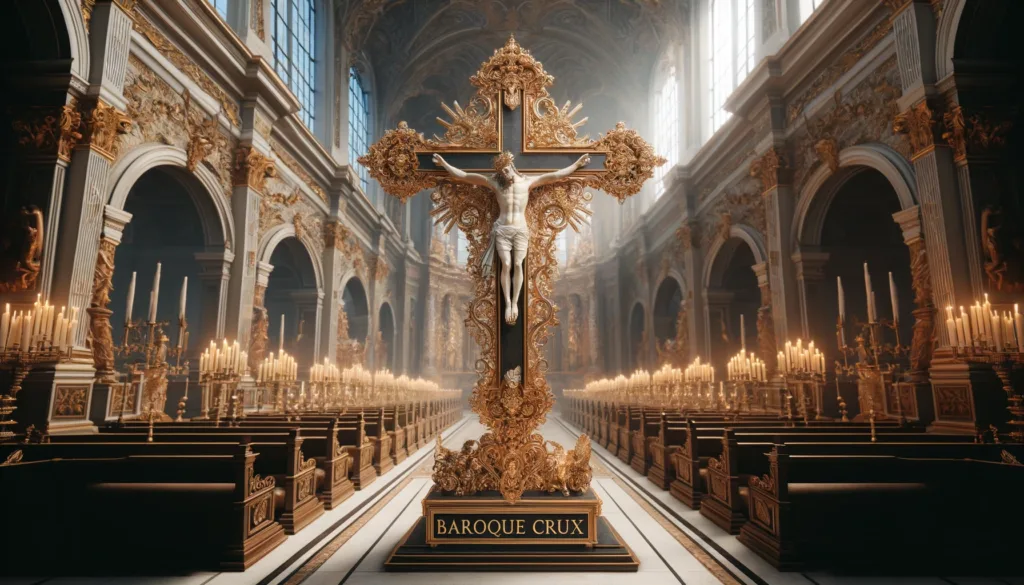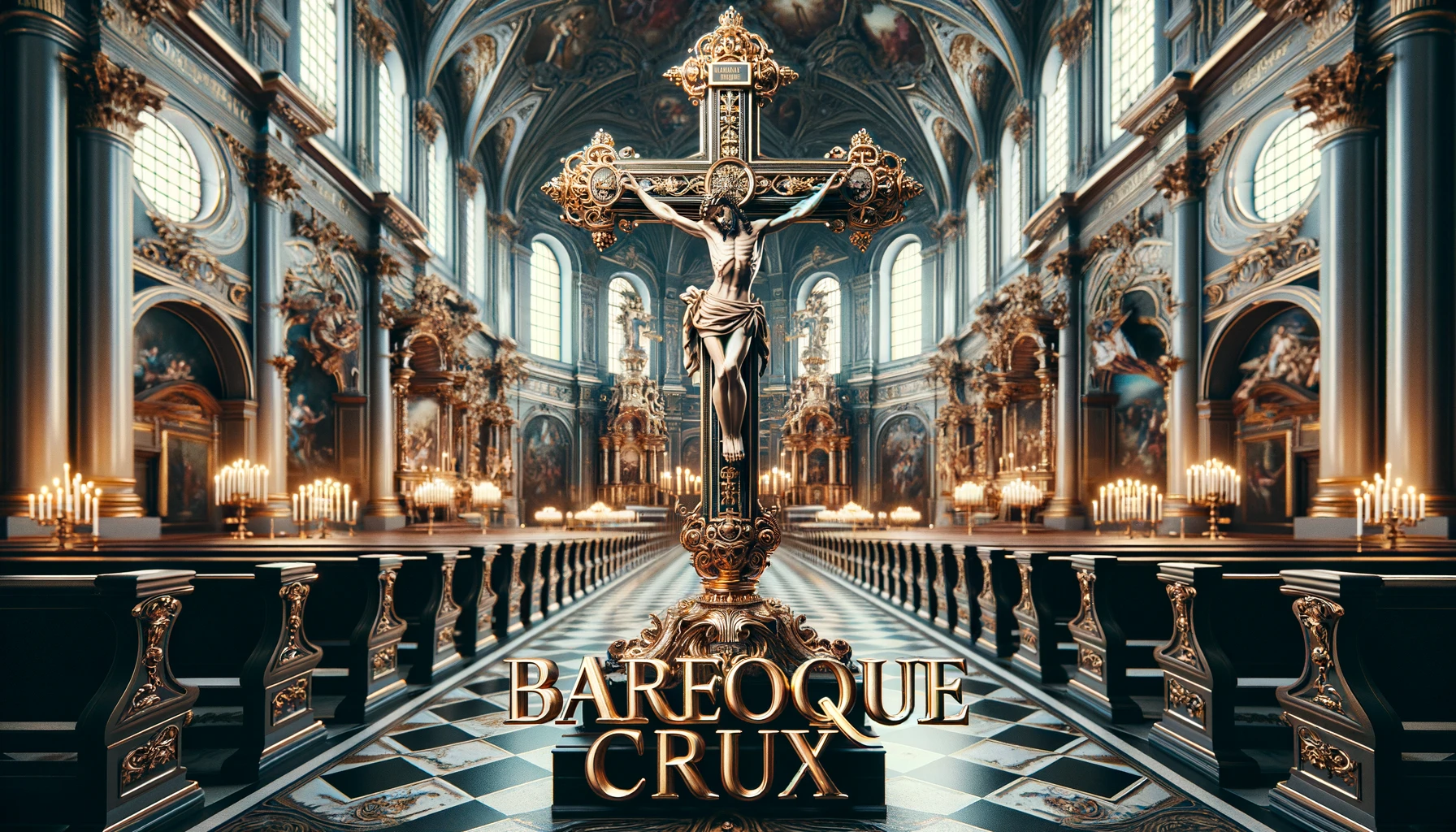A Baroque crux, or crucifix, is an ornate representation of the crucifixion of Jesus Christ, typical of the Baroque period (17th to early 18th centuries). This style is marked by dramatic detail, intricate designs, and a heightened sense of emotion and movement. These crucifixes were created not just as religious symbols but as powerful artistic pieces meant to evoke deep contemplation and emotional responses from viewers.
The Baroque Influence
The Baroque period was known for its emphasis on realism, emotion, and dramatic contrasts of light and shadow, techniques perfected by artists like Caravaggio and Rubens. These elements are present in the crucifixes of this era, making them not only religious artifacts but also masterpieces of art. By engaging with a Baroque crucifix, you are connecting with a rich tradition of faith and artistic expression that sought to make the divine more tangible and accessible to the faithful
Definition of Baroque
The term “Baroque” refers to a style of art, architecture, and music that emerged in Europe around the 17th century and lasted until the early 18th century. This style is characterized by elaborate ornamentation, dynamic movement, dramatic use of light and shadow (chiaroscuro), and an overall sense of grandeur and emotional intensity. Baroque art aimed to evoke strong emotions and create a sense of awe and reverence through its intricate designs and powerful imagery.
Definition of Crux
“Crux” is a Latin term that means “cross.” In a broader sense, it refers to a vital, decisive, or most important point of an issue. In the context of Christian art and symbolism, the crux specifically denotes the cross on which Jesus Christ was crucified, serving as a central emblem of the Christian faith.
Connection Between Baroque and Crux
The Baroque period was deeply influenced by the Counter-Reformation, a movement within the Catholic Church that sought to reaffirm its doctrines and counter the spread of Protestantism. Art and religious imagery became essential tools in this effort, with the crux (cross) playing a central role. Baroque crucifixes (Baroque crux) were designed not only as religious symbols but also as powerful artistic expressions meant to evoke deep emotional and spiritual responses from the faithful. The combination of Baroque artistry with the symbolic importance of the crucifix created pieces that were both visually stunning and spiritually profound.
How to Appreciate the Baroque Crux, real or AI generated
When you observe a Baroque crucifix, you’re not just looking at a piece of religious art; you’re engaging with a historical artifact designed to communicate intense spiritual narratives. The craftsmanship often includes detailed carvings, gilding, and sometimes even polychrome (multi-colored) finishes that bring the figures to life. For example, the Baroque Siena hand-painted Italian crucifix is known for its exquisite detailing and lifelike representation, enhancing the emotional and spiritual impact

Artificial Intelligence (AI) can significantly enhance the generation of Baroque cruxes by streamlining the design and production processes. AI-driven design software can analyze historical Baroque art to identify key stylistic elements and patterns, enabling the creation of highly detailed and accurate reproductions or new designs inspired by the Baroque style. By using machine learning algorithms, these tools can predict the most aesthetically pleasing combinations of ornamentation, figures, and colors, ensuring that each crucifix resonates with the intricate and dramatic essence of the Baroque period. Additionally, AI can assist in 3D modeling and printing, allowing for precise and efficient production of these complex designs. This technology not only preserves the artistic integrity of traditional Baroque craftsmanship but also makes it accessible for contemporary use in churches and religious institutions, ensuring that these symbols continue to inspire and evoke deep spiritual reflection.
Using the Baroque Crux in Your Space
Incorporating a Baroque crux into your home or place of worship can create a focal point for meditation and prayer. Place it in a quiet area where you can sit and reflect, allowing the detailed artistry to draw you into a deeper spiritual experience. The positioning of the crucifix can also be symbolic; for instance, placing it at eye level can help maintain a sense of humility and reverence.
Use of Baroque Crux in a Church
In a church setting, a Baroque crux serves multiple purposes:
- Liturgical Use: The crucifix is placed on or near the altar, serving as a focal point during the Mass and other liturgical services. Its presence reminds worshippers of Christ’s sacrifice and fosters a sense of reverence and contemplation.
- Aesthetic and Emotional Impact: The dramatic and intricate design of a Baroque crucifix enhances the visual appeal of the church interior. The detailed craftsmanship and use of light and shadow draw the congregation’s attention, helping them to engage more deeply with their faith.
- Educational Tool: The vivid and realistic portrayal of Christ’s crucifixion in Baroque art can serve as a teaching tool, illustrating biblical stories and theological concepts to the faithful. It helps to communicate the suffering and sacrifice of Christ in a more tangible and relatable manner.
- Spiritual Focus: In personal prayer and meditation, the Baroque crux can serve as a powerful visual aid. Its detailed depiction encourages worshippers to reflect on the Passion of Christ and deepen their personal devotion.

